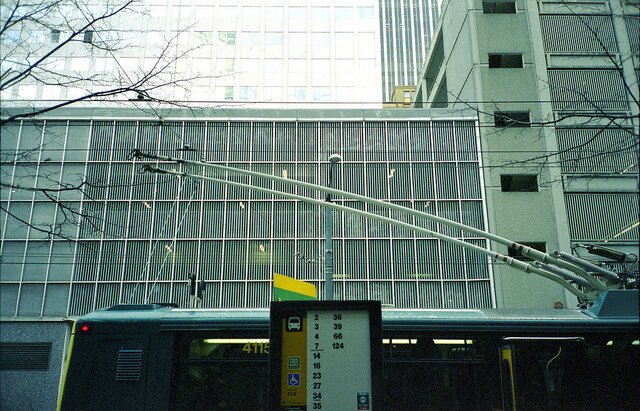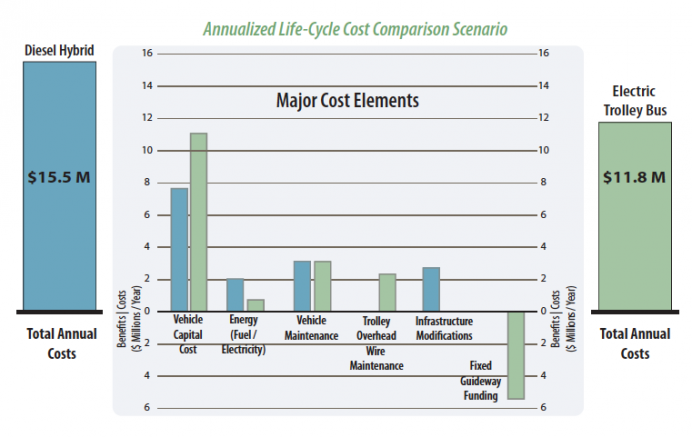
King County Metro Transit has been kicking bus-power tires, trying to decide whether or not to stick with its fleet of 159 electric trolley buses as they near the end of their useful lives, and need to be replaced over the course of 2013 to 2014.
The trolley buses run through Seattle, 14 routes along nearly 70 miles of overhead electrified wire, and in 2010, Seattle’s Department of Transportation was pushing Metro to adopt diesel hybrids [UPDATE: SDOT writes to say: “SDOT has very clearly opposed any plan that would replace electric trolleys with diesel/diesel hybrid buses, without exception,” and clarifies that the notion of switching was all Metro’s] instead, after a quick-and-dirty audit seemed to show that electrics were more expensive. (The annual cost worked out to Hybrid bus: $141,878 per year vs. Trolley: $177,318.)
This idea met with an immediate popular outcry, as the electric trolley buses are much quieter than the diesel-powered hybrids, and unsurprisingly, smell less like diesel exhaust. Thankfully, we live in Seattle, where a new study to contradict the old study is just a wish away. The King County Council asked Metro for a full cost analysis, and the preliminary findings lean heavily in favor of electric trolleys, as you might expect if you have checked diesel prices lately.
The transit wonks at Seattle Transit Blog underscore one clear area of high performance: “On environmental criteria, the trolleybuses came out ahead on every metric except visual impact. As Seattle City Light’s energy comes mostly from hydro, the Carbon footprint was much smaller.”
But what happened to the conclusion of last year’s audit: “Transit could save $8.7 million per year by replacing the trolley buses with hybrid diesel/electric buses, through cost and scheduling efficiencies”?
It turns out that that audit skipped over a few details, explains Metro’s Chris O’Claire. For starters, it left out the cost of decommissioning the electric system (removing wires and changing out transformers), and it turns out that to handle the extra diesel hybrids, Metro would have to add fueling stations (estimated at around $5 million alone). For maintenance costs, the audit relied on Metro’s current fleet’s costs, whereas for the new study, Metro built off the maintenance costs from other transit systems using new trolley buses.
If you look more closely at all the costs, then, you get the chart below:

But even better, as the Slog notes, new electric trolleys would come with a power assist so that they can briefly go off-wire, and bypass anything that’s stuck in front of them. That tendency for trolleys to stack up powerlessly counted against them in last year’s audit; with the new buses, it wouldn’t.
Metro hasn’t decided on a generator or battery at this point, says O’Claire–a diesel generator could provide as much as 20 to 30 miles of off-wire travel, but Metro estimates that a mile to a mile and a half is all that would be needed. Even if a whole segment of wire goes down, 90 percent of the system’s circuits are within a mile of each other, so the bus could travel wirelessly until it reached a working power source again.
To learn more about the study, and add your comments, as it’s still in progress, you’re invited to stop by a King County Metro Transit open house on Wednesday, April 27, from 5 p.m. to 7 p.m. in Hildebrand Hall at Plymouth Congregational Church (1217 Sixth Ave., Seattle). Once a decision is made, and after the county approves the budget in November 2011, Metro can begin the actual bus procurement process in 2012.
My favorite part of the Trolley Evaluation Preliminary Findings –
Removal of anchor bolts and overhead wires may impact historic structures.
Ah, didn’t you guys ‘impact’ historic structures when you drilled the bolts into the historic buildings in the 1st place? And how does removing the wires (leave the bolts in place if they’re so critical) ‘impact’ historic structures – these buildings have gotten used to the obscured view and will be bummed if they get a clear shot at the sky??
Of course ‘impact’ is value-neutral, so perhaps they’re talking about a positive impact, but I doubt it. ‘Impact’ is bureaucratese for ‘negative effect’
Also interesting – the chart shows the fuel costs as surprisingly small in either scenario. Yet, when fuel prices rise, we always seem to hear about how much it’s going to cost the transit system. The charts don’t show even a 25% fuel increase having a substantial (negative) impact.
Those anchor bolts have been in the buildings since they were built. They were used by the streetcar system before conversion to “Trackless Trolleys”. They are also part of the building code for any new construction.
So why are they talking about removing them? Makes even less sense if having these bolts are code
I would guess that if the overhead wire is no longer needed in Seattle, because the Trolleybuses get replaced with Diseasels, then the property owners may demand that KC Metro remove the anchors. It’s a straw argument, and these same anchors might be needed for future streetcar installation, but one must consider all factors and impacts and mitigations when compiling these types of reports.
Seattle City Light fully offsets all the carbon emissions related to its operations. City Light started this in 2005, the first electric utility in the nation to do so. As a result, the carbon footprint for using City Light electricity is zero.
I suggest that Seattle consider the off-wire method used on Philadelphia’s electric trolley coaches, called trackless trolleys there. The new trackless trolleys feature a small Diesel powered generator to operate off-wire . By using this method, there is excellent range and no need to recharge batteries. It’s actually possible to operate Philly’s trackless trolleys several miles off-wire for detours or emergencies. Philly’s trackless trolleys also feature semi-automatic trolley poles that lower at the touch of a dashboard button by the operator.